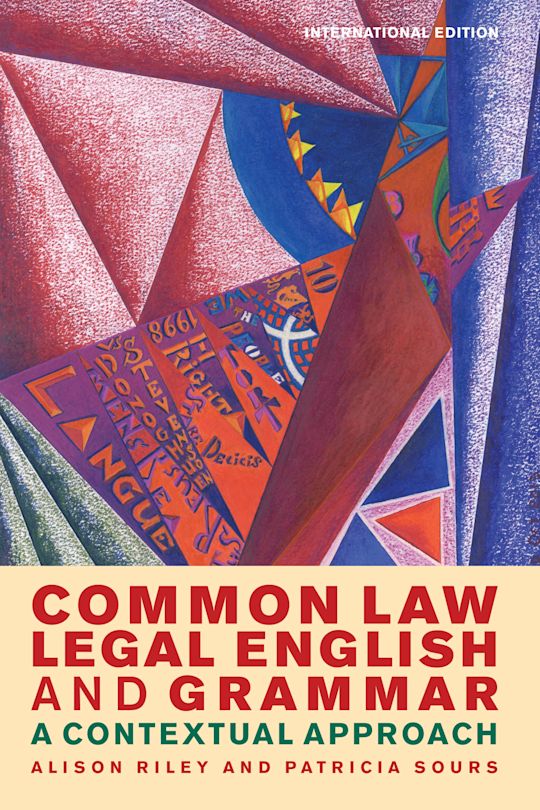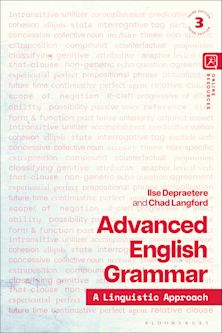- Home
- ACADEMIC
- Linguistics
- Grammar, Syntax and Morphology
- Common Law Legal English and Grammar
Common Law Legal English and Grammar
A Contextual Approach
- Textbook
Common Law Legal English and Grammar
A Contextual Approach
- Textbook
Please note that this product is not available for purchase from Bloomsbury websites.
Buy from Bloomsbury eTextBooks
You are now leaving the Bloomsbury Publishing website. Your eBook purchase will be with our partner https://www.vitalsource.com.
Your credit card statement will show this purchase originating from VitalSource Technologies. They will also provide any technical assistance you might require.
You must sign in to add this item to your wishlist. Please sign in or create an account
Description
Lord Denning, an influential but controversial English judge, stated that 'Words are the lawyer's tools of trade'. This course book reflects that conviction as it focuses on words, the language of the law - legal terms, expressions, and grammar - introduced systematically with relevant aspects of the law, and examined in context through analytical reading activities based on original legal texts selected for their interest and importance in different branches of the common law system. This book explores constitutional law, criminal law, tort, and contract; yet includes international legal contexts, with a particular focus on human rights and European law. The presentation of legal concepts and terminology in context in each chapter is graded so that the course progresses, building on the vocabulary and law encountered in earlier chapters. Each chapter, organized thematically, includes a series of activities - tasks - to complete, yet the book does not presuppose previous knowledge of legal English or of the common law: full answer keys and reflective commentary on both legal and linguistic aspects are given and sections marked 'Advanced' offer especially challenging materials. Consolidation sections are designed to test students' global comprehension of the legal texts analysed, including precise usage of legal vocabulary in context, with solutions. Common Law Legal English and Grammar is addressed to the non-native speaker of English, and in particular, intermediate to advanced students who are studying law, or academics with a professional interest in Anglo-American law. Practising lawyers will also find that the book offers valuable analysis of the language of legal documents. Please note, this book is not available for purchase in Italy.
Table of Contents
Chapter 1 Language and Law – English Legal Contexts, Texts and Terminology
Chapter 2 Legal Grammar – Text Layout and Use of Formal Terminology
Part II The Language of a Legal System and the British Constitution
Chapter 3 Language and Law – Sources of Law and the Constitution of the UK
Chapter 4 Legal Grammar – Punctuation
Consolidation Part II – Language Focus Tasks
Part III International Treaties, Human Rights and European Integration
Chapter 5 Language and Law – Treaties and Human Rights in the European Dimension
Chapter 6 Legal Grammar – Basic Sentence Structure
Chapter 7 Language and Law – Common Law Perspectives of Crime and Punishment
Chapter 8 Legal Grammar – Verb Forms
Chapter 9 Language and Law – Judicial Precedent and the Law of Torts
Chapter 10 Legal Grammar – Word Formation
Chapter 11 Language and Law – Contract and Commercial Agreements
Chapter 12 Legal Grammar – Adverbial Clauses and Nominal Structures
Product details
| Published | Dec 01 2014 |
|---|---|
| Format | Ebook (PDF) |
| Edition | 1st |
| Extent | 528 |
| ISBN | 9781849467575 |
| Imprint | Hart Publishing |
| Publisher | Bloomsbury Publishing |
About the contributors
Reviews
-
The book provides the reader with a vast and thorough analysis of the legal language; however, we should not be discouraged by the 503 pages of the book, since the authors use plain English and clearly explain the features of the legal jargon.
... definitely the title to remember for those interested in not only learning legal English terminology but also understanding the usage of the legal terms of art in context. The authors teach the readers legal terminology but also equip them with legal knowledge. They use brilliant and memorable examples to illustrate the use of language, selecting them from the history of common law but also literature and news satisfying in this way the tastes of both lawyers are linguists.
I will strongly recommend the book to my colleagues - legal English practitioners - as well as my most ambitious and linguistically advanced law students.Aleksandra Luczak, Kozminski University, www.luczak.edu.pl


































